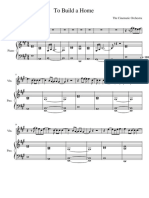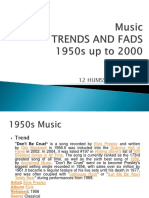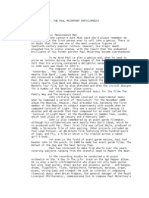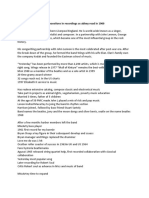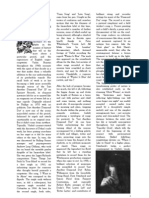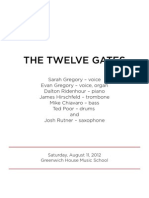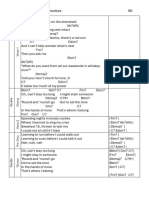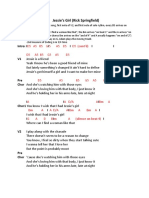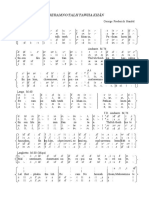Donovan: A Promotional Poster For The Single From The UK
Donovan: A Promotional Poster For The Single From The UK
Uploaded by
Lak DavisCopyright:
Available Formats
Donovan: A Promotional Poster For The Single From The UK
Donovan: A Promotional Poster For The Single From The UK
Uploaded by
Lak DavisOriginal Title
Copyright
Available Formats
Share this document
Did you find this document useful?
Is this content inappropriate?
Copyright:
Available Formats
Donovan: A Promotional Poster For The Single From The UK
Donovan: A Promotional Poster For The Single From The UK
Uploaded by
Lak DavisCopyright:
Available Formats
Paul McCartney came up with the melody of Eleanor Rigby as he experimented with his piano.
However, the name the of the protagonist he chose was not Eleanor Rigby but Miss Daisy Hawkins. Donovan reported that he heard McCartney play it to him before it was finished with completely different lyrics.[5] In 1966, McCartney recalled how he got the idea for his song:
A promotional poster for the single from the UK.
I was sitting at the piano when I thought of it. The first few bars just came to me, and I got this name in my head... 'Daisy Hawkins picks up the rice in the church'. I don't know why. I couldn't think of much more so I put it away for a day. Then the name Father McCartney came to me, and all the lonely people. But I thought that people would think it was supposed to be about my Dad sitting knitting his socks. Dad's a happy lad. So I went through the telephone book and I got the name 'McKenzie'.[6] Others believe that "Father McKenzie" refers to "Father" Tommy McKenzie, who was the compereat Northwich Memorial Hall.[7][8] McCartney said he came up with the name "Eleanor" from actress Eleanor Bron, who had starred with the Beatles in the film Help!. "Rigby" came from the name of a store in Bristol, "Rigby & Evens Ltd, Wine & Spirit Shippers", that he noticed while seeing his girlfriend of the time, Jane Asher, act in The Happiest Days of Your Life. He recalled in 1984, "I just liked the name. I was looking for a name that sounded natural. 'Eleanor Rigby' sounded natural." However, it has been pointed out that the graveyard of St Peter's Church in Liverpool, where John Lennon and Paul McCartney first met on the Woolton Village garden fete in the afternoon of 6 July 1957, contains the gravestone of an individual called Eleanor Rigby. Paul McCartney has conceded he may have been subconsciously influenced by the name on the gravestone.[9] Bizarrely, the real Eleanor Rigby lived a lonely life similar to that of the person in the song.[10] McCartney wrote the first verse by himself, and the Beatles finished the song in the music room of John Lennon's home at Kenwood. John Lennon, George Harrison, Ringo Starr, and their friend Pete
Shotton all listened to McCartney play his song through and contributed ideas. Starr contributed the line "writing the words of a sermon that no one will hear " and suggested making "Father McCartney" darn his socks, which McCartney liked. Shotton then suggested that McCartney change the name of the priest, in case listeners mistook the fictional character in the song for McCartney's own father.[11] The song is often described as a lament for lonely people[12] or a commentary on post-war life in Britain.[13][14] McCartney could not decide how to end the song, and Shotton finally suggested that the two lonely people come together too late as Father McKenzie conducts Eleanor Rigby's funeral. At the time, Lennon rejected the idea out of hand, but McCartney said nothing and used the idea to finish off the song, later acknowledging Shotton's help.[11] Lennon was quoted in 1972 as having said that he wrote 70% of the lyrics,[15] and in 1980 claimed that he wrote all but the first verse,[16] but Pete Shotton, Lennon's childhood friend, remembered Lennon's contribution as being "absolutely nil".[17] McCartney said that "John helped me on a few words but I'd put it down 80-20 to me, something like that."[18]
Musical structure[edit]
The song is a prominent example of mode mixture; specifically between the Aeolian mode, also known as natural minor, and the Dorian mode: the song, in E minor, is based on the chord progression Em-C, a chord progression in the Aeolian mode (utilizing notes 3, 6, and 7 in this scale; see article). The lead melody, however, is taken primarily from the somewhat lighter Dorian mode (minor scale with sharpened sixth degree; see article).[19] The song opens with a C-major vocal harmony ("Aah, look at all..."), before shifting to i (Em) on "lonely people"). The Aeolian C natural note returns later in the verse on the word "dre-eam" (C-B) as the C chord resolves to the tonic Em, giving an urgency to the melody's mood. The Dorian mode appears with the C# note (6 in the Em scale) at the beginning of the phrase "in the church".[20] The chorus beginning "All the lonely people" involves the viola in a chromatic descent to the 5th; from 7 (D natural on "All the lonely peo..") to 6 (C on "...ple") to 6 (C on"they) to 5 (B on "from"). This is said to "add an air of inevitability to the flow of the music (and perhaps to the plight of the characters in the song)".[21]
Historical artifacts[edit]
The gravestone of the "real" Rigby, St. Peter's Parish Church, Woolton, August 2008
In the 1980s, a grave of an Eleanor Rigby was "discovered" in the graveyard of St. Peter's Parish Church in Woolton, Liverpool, and a few yards away from that, another tombstone with the last name "McKenzie" scrawled
You might also like
- Rock Pop PianoDocument118 pagesRock Pop PianoLak Davis98% (41)
- Informative Speech OutlineDocument4 pagesInformative Speech OutlineBryan GonzalezNo ratings yet
- To Build A HomeDocument7 pagesTo Build A HomeAna Lopez100% (3)
- Dreaming the Beatles: The Love Story of One Band and the Whole WorldFrom EverandDreaming the Beatles: The Love Story of One Band and the Whole WorldRating: 4 out of 5 stars4/5 (54)
- Sungha Jung My Heart Will Go OnDocument6 pagesSungha Jung My Heart Will Go OnLak Davis100% (1)
- Guthrie Govan: West Coast GroovesDocument7 pagesGuthrie Govan: West Coast Groovesla pose del pensadorNo ratings yet
- Árvore Genealógica - Situação Da Base de Dados em 19 de Abril de 2013Document2 pagesÁrvore Genealógica - Situação Da Base de Dados em 19 de Abril de 2013Kaylan TomichNo ratings yet
- Eleanor RigbyDocument22 pagesEleanor RigbyGregor McGill0% (1)
- Early Beatles Songs PDFDocument43 pagesEarly Beatles Songs PDFRonny Stienen100% (1)
- Bill Harry - The Paul McCartney Encyclopedia 4Document155 pagesBill Harry - The Paul McCartney Encyclopedia 4david.barnes386240No ratings yet
- BlackbirdDocument3 pagesBlackbirdscorbagNo ratings yet
- Resident Evil 5Document4 pagesResident Evil 5Lak DavisNo ratings yet
- Hofstra SM Handbook Spring 2018 PDFDocument80 pagesHofstra SM Handbook Spring 2018 PDFBecky SkolnickNo ratings yet
- Alto SaxDocument12 pagesAlto SaxmabekNo ratings yet
- Eleanor RigbyDocument7 pagesEleanor RigbytzvingNo ratings yet
- YesterdayDocument2 pagesYesterdaydoc_masanNo ratings yet
- I'm A LoserDocument4 pagesI'm A LoserJon StewartNo ratings yet
- Two Dozen Standards (Iverson - Kanan)Document83 pagesTwo Dozen Standards (Iverson - Kanan)jsm329No ratings yet
- Elton John: Fifty Years On: The Complete Guide to the Musical Genius of Elton John and Bernie TaupinFrom EverandElton John: Fifty Years On: The Complete Guide to the Musical Genius of Elton John and Bernie TaupinNo ratings yet
- Quiz de InglêsDocument7 pagesQuiz de InglêssenamariojuniordossantossenaNo ratings yet
- Let It BeDocument4 pagesLet It BeJoel Igno TadeoNo ratings yet
- 12 Humss (Jose)Document15 pages12 Humss (Jose)Mark Joseph R. MechelinaNo ratings yet
- Paul McCartney Encyclopedia PDFDocument723 pagesPaul McCartney Encyclopedia PDFFlipdaBoid100% (1)
- My Ding A LingDocument3 pagesMy Ding A LingRog DonNo ratings yet
- British BandsDocument5 pagesBritish Bandssevcan AslanNo ratings yet
- Imagine by John LennonDocument3 pagesImagine by John Lennonmichelle12wong4000No ratings yet
- Bill Harry - The Paul McCartney Encyclopedia 16Document15 pagesBill Harry - The Paul McCartney Encyclopedia 16david.barnes386240No ratings yet
- American Pie LyricsDocument15 pagesAmerican Pie Lyricsapi-268939308No ratings yet
- Help 122Document2 pagesHelp 122shinobi200No ratings yet
- StairwayDocument15 pagesStairwayNorbert KurunciNo ratings yet
- The Beatles - Paul ShiptonDocument47 pagesThe Beatles - Paul ShiptonрозаNo ratings yet
- The Beatles (Level 3)Document29 pagesThe Beatles (Level 3)Erkhemee OnAir100% (4)
- List of Songs Recorded by The BeatlesDocument18 pagesList of Songs Recorded by The BeatlestommyhaaNo ratings yet
- Beach Boys Vs Beatles EssayDocument5 pagesBeach Boys Vs Beatles EssaytaniamadiganNo ratings yet
- Night and DayDocument3 pagesNight and DaycorreoftNo ratings yet
- SONG ANALYSIS SAC - Unit 2 VCE - OC3 - SampleDocument2 pagesSONG ANALYSIS SAC - Unit 2 VCE - OC3 - SamplelijndersdjNo ratings yet
- The Beatles Ingles 1803Document3 pagesThe Beatles Ingles 1803Verónica ArandaNo ratings yet
- The History of Rock Music: 1955-1966Document6 pagesThe History of Rock Music: 1955-1966sarna3210No ratings yet
- Untitled Presentation-6Document20 pagesUntitled Presentation-6api-535208903No ratings yet
- Paul Mccartney Songs and Best Albums. Innovations in Recordings As Abbey Road in 1960Document3 pagesPaul Mccartney Songs and Best Albums. Innovations in Recordings As Abbey Road in 1960Tere DíazNo ratings yet
- Concert CritiqueDocument4 pagesConcert CritiqueTatyana HarrisonNo ratings yet
- The Beatles PDFDocument45 pagesThe Beatles PDFLaia Fort Tura100% (1)
- The BeatlesDocument5 pagesThe BeatlesSierra SpadeNo ratings yet
- Vashti Bunyan PT30Document11 pagesVashti Bunyan PT30Onuba ConqueroNo ratings yet
- The Musical Characteristics of The Beatles: Michael SaffleDocument28 pagesThe Musical Characteristics of The Beatles: Michael SaffleEng Stephen ArendeNo ratings yet
- Book Excerpt From "Dreaming The Beatles" by Rob SheffieldDocument10 pagesBook Excerpt From "Dreaming The Beatles" by Rob SheffieldOnPointRadio100% (1)
- Making Music Together: From Tanglewood to Boston to Philadelphia and BeyondFrom EverandMaking Music Together: From Tanglewood to Boston to Philadelphia and BeyondNo ratings yet
- Biography of Paul McCartneyDocument13 pagesBiography of Paul McCartneyPEDROALTAMIRANONo ratings yet
- Musica en Joyce Artículo de Don WardDocument36 pagesMusica en Joyce Artículo de Don WardRed MaorinovicNo ratings yet
- Essays on MusicDocument95 pagesEssays on MusicJason EspadaNo ratings yet
- A Tribute To Jackie LevenDocument11 pagesA Tribute To Jackie LevenJohn CrowtherNo ratings yet
- Summary of Kenneth Womack & Jason Kruppa's All Things Must Pass AwayFrom EverandSummary of Kenneth Womack & Jason Kruppa's All Things Must Pass AwayNo ratings yet
- The Twelve Gates at Greenwich House Music School - Program NotesDocument2 pagesThe Twelve Gates at Greenwich House Music School - Program NotesJosh RutnerNo ratings yet
- Mitteilungen Pss 24 Kate MeehanDocument5 pagesMitteilungen Pss 24 Kate MeehanauxiliaNo ratings yet
- One Track Forward, Two Tracks Back - Old Music, New MusickingDocument4 pagesOne Track Forward, Two Tracks Back - Old Music, New MusickingHải Nguyễn ThanhNo ratings yet
- The Lyrics of Leonard Cohen: Enhanced EditionFrom EverandThe Lyrics of Leonard Cohen: Enhanced EditionRating: 5 out of 5 stars5/5 (7)
- Mars Is The Fourth Planet From The Sun and The Second Smallest Planet in The Solar SystemDocument3 pagesMars Is The Fourth Planet From The Sun and The Second Smallest Planet in The Solar SystemLak DavisNo ratings yet
- Academy Award For Best PictureDocument4 pagesAcademy Award For Best PictureLak DavisNo ratings yet
- Pluto: This Article Is About The Dwarf Planet. For Other Uses, SeeDocument7 pagesPluto: This Article Is About The Dwarf Planet. For Other Uses, SeeLak DavisNo ratings yet
- Modem: For Other Uses, SeeDocument3 pagesModem: For Other Uses, SeeLak DavisNo ratings yet
- Oscars 2014Document4 pagesOscars 2014Lak DavisNo ratings yet
- EconomicsDocument4 pagesEconomicsLak DavisNo ratings yet
- Russia: Russian Federation Российская ФедерацияDocument5 pagesRussia: Russian Federation Российская ФедерацияLak DavisNo ratings yet
- Duck (Food) Duck (Disambiguation) Duckling (Disambiguation)Document4 pagesDuck (Food) Duck (Disambiguation) Duckling (Disambiguation)Lak DavisNo ratings yet
- Economic ShortageDocument2 pagesEconomic ShortageLak DavisNo ratings yet
- Polar Bear: This Article Is About The Animal. For Other Uses, SeeDocument5 pagesPolar Bear: This Article Is About The Animal. For Other Uses, SeeLak DavisNo ratings yet
- Production (Economics) : Production As A Source of Economic Well-BeingDocument3 pagesProduction (Economics) : Production As A Source of Economic Well-BeingLak DavisNo ratings yet
- Falcon: "Tercel" Redirects Here. For The Car, See - For Other Uses, SeeDocument6 pagesFalcon: "Tercel" Redirects Here. For The Car, See - For Other Uses, SeeLak DavisNo ratings yet
- Giant Panda: "Panda" Redirects Here. For Other Uses, SeeDocument6 pagesGiant Panda: "Panda" Redirects Here. For Other Uses, SeeLak DavisNo ratings yet
- MarketDocument6 pagesMarketLak DavisNo ratings yet
- Phascolarctidae Bear (Disambiguation) Ursine, NevadaDocument6 pagesPhascolarctidae Bear (Disambiguation) Ursine, NevadaLak DavisNo ratings yet
- Pinniped: From Wikipedia, The Free EncyclopediaDocument7 pagesPinniped: From Wikipedia, The Free EncyclopediaLak DavisNo ratings yet
- Giraffe: For Other Uses, SeeDocument4 pagesGiraffe: For Other Uses, SeeLak DavisNo ratings yet
- Isaac NewtonDocument6 pagesIsaac NewtonLak DavisNo ratings yet
- PlanckDocument5 pagesPlanckLak DavisNo ratings yet
- Quantum PhysicsDocument9 pagesQuantum PhysicsLak DavisNo ratings yet
- Resident EvilDocument4 pagesResident EvilLak DavisNo ratings yet
- BirdemicDocument3 pagesBirdemicLak DavisNo ratings yet
- Jaws (Film) : From Wikipedia, The Free EncyclopediaDocument3 pagesJaws (Film) : From Wikipedia, The Free EncyclopediaLak DavisNo ratings yet
- SharknadoDocument3 pagesSharknadoLak DavisNo ratings yet
- Whose Line Is It AniwayDocument4 pagesWhose Line Is It AniwayLak DavisNo ratings yet
- Unit II Elements of Dance Rhythm Fundamental PositionDocument13 pagesUnit II Elements of Dance Rhythm Fundamental Positions.prosia.maviemhoniqueNo ratings yet
- No HandsDocument2 pagesNo Handsmaurizio reolonNo ratings yet
- Berklee College of Music - SlideRoom - SubmissionDocument3 pagesBerklee College of Music - SlideRoom - SubmissiontanNo ratings yet
- Download full The Golden Bough Sir James George Frazer ebook all chaptersDocument81 pagesDownload full The Golden Bough Sir James George Frazer ebook all chapterstishiaqaye100% (1)
- Exotic 2007 09Document48 pagesExotic 2007 09vduata20No ratings yet
- WandaVision Episode 1 Schaeffer It Starts On The PageDocument38 pagesWandaVision Episode 1 Schaeffer It Starts On The PageLuke JonesNo ratings yet
- Christ Be MagnifiedDocument2 pagesChrist Be Magnifiedmbakevin5No ratings yet
- 12 Singing Performance Grades Syllabus 2nd Edn 220721Document81 pages12 Singing Performance Grades Syllabus 2nd Edn 220721Maria AndreouNo ratings yet
- LM Ruta6Document38 pagesLM Ruta6Sebastian MonNo ratings yet
- BridgeDocument11 pagesBridgeMartin Berger100% (1)
- Guardia Nacional Enero 2019Document400 pagesGuardia Nacional Enero 2019Jhon David AnatoNo ratings yet
- Final Project Van HalenDocument3 pagesFinal Project Van Halenapi-295963445No ratings yet
- Jacob Do Bandolim - O Vôo Da MoscaDocument4 pagesJacob Do Bandolim - O Vôo Da MoscaEmmanuel CoelhoNo ratings yet
- Elizabeth Barrett Browning Sonnet 32Document2 pagesElizabeth Barrett Browning Sonnet 32api-270897909100% (1)
- Jessie's GirlDocument3 pagesJessie's GirlEricNo ratings yet
- Nal'ibali - A Birthday Wish (English)Document4 pagesNal'ibali - A Birthday Wish (English)CityPressNo ratings yet
- Personal Narrative EssayDocument7 pagesPersonal Narrative EssayKevin GonzalezNo ratings yet
- Beram No Talh Tawh A (Hlapui) PDFDocument4 pagesBeram No Talh Tawh A (Hlapui) PDFTluanga Lal FanaiNo ratings yet
- Begins With The Oboe A History of The Toronto Symphony Orchestra 9781442671232 CompressDocument301 pagesBegins With The Oboe A History of The Toronto Symphony Orchestra 9781442671232 CompressGeorge BestNo ratings yet
- French Glossary For Math PDFDocument79 pagesFrench Glossary For Math PDFlastname nameNo ratings yet
- Listening Report On Vivaldi AutumnDocument2 pagesListening Report On Vivaldi AutumnJoy Danielle LlandinoNo ratings yet
- Collins John Bull Canon PDFDocument30 pagesCollins John Bull Canon PDFBuciu Petre50% (2)
- Brahms - Cadenza For Mozart's Piano Concerto in D Minor, KDocument4 pagesBrahms - Cadenza For Mozart's Piano Concerto in D Minor, Kapi-3705759No ratings yet
- The 7th Disruption Ebook PDFDocument30 pagesThe 7th Disruption Ebook PDFAbhinav Garg100% (1)


